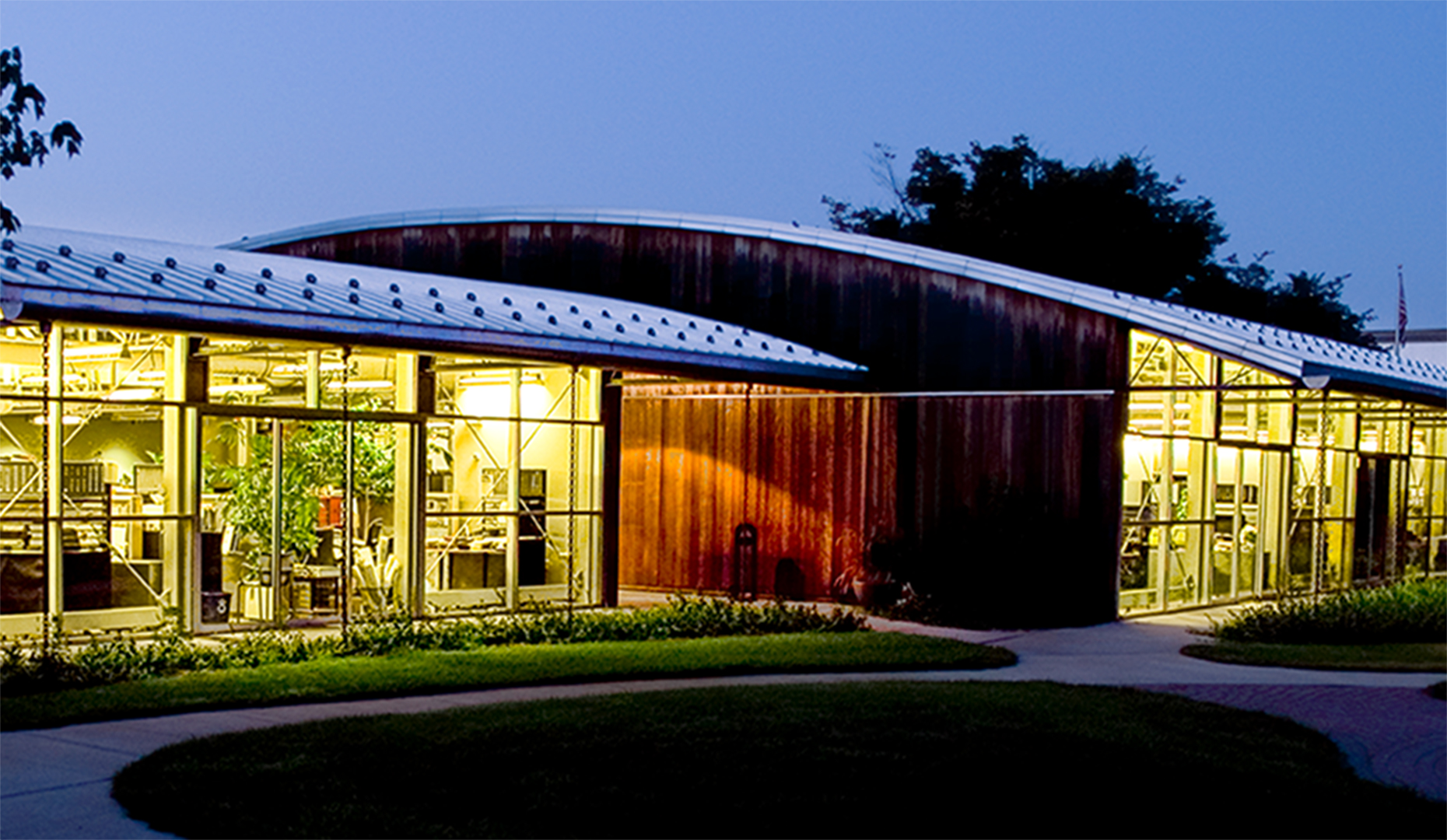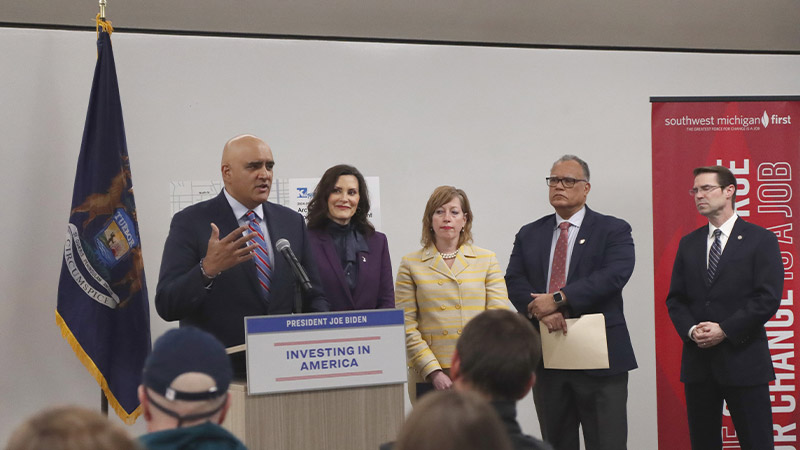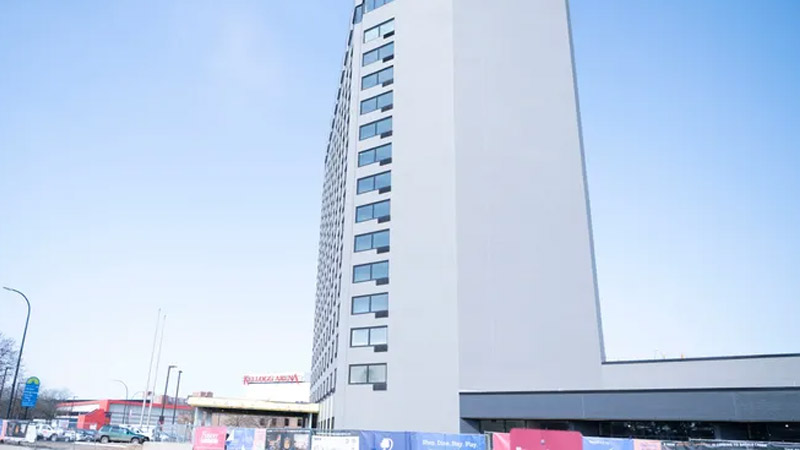Landscape Forms’ outdoor designs solve problems and shape strategy.
Hungarian inventor, architect, and professor of architecture Ernö Rubik invented the Rubik’s Cube 40 years ago. What has become one of the world’s top-selling puzzle games was originally created to build Rubik’s students’ problem solving skills at the Academy of Applied Arts and Crafts in Budapest. How could they get the pieces to move without falling apart?
The job of an architect is to design and construct something. But it’s so much more, according to an actual architect or product designer: it’s more about problem-solving. In the case of a six-sided, six-colored cube, it’s more like getting cubes to move in harmony or getting similar colors to appear on the same face.
Landscape Forms, the industry leader in integrated collections of high-design site furniture and advanced LED lighting headquartered in Comstock Township, approaches its business model based on superior product designs in that manner.
“You see a problem to solve, whether it’s how people sit outside or how people interact in outdoor environments, and then you come up with the most artful way of problem solving. That’s really what our company is all about,” says Richard Heriford, president of Landscape Forms. “Design to Landscape Forms is not just about product design or graphic design or brochures. It’s really about creative problem solving in every aspect of the business.”
Kirt Martin, vice president of Design and Marketing, confirms, “Product design is getting out in the field. It’s understanding behaviors and troubles and having some empathy for what’s happening out there.”
Design and its accompanying creativity are at the heart of the company’s founding principles. The company itself was started in 1969 with the intent to solve a problem: Landscape architect John E. Chipman got tired of having to lay off his production crew during the winter time. He came up with the idea that they could make furniture as opposed to plowing snow, which wasn’t very creative. With his wish to do something creative, and keep his people employed in the winter, Chipman essentially formed the commercial outdoor furniture industry.
Today, Landscape Forms’ products are found in some of the world’s most iconic outdoor places. Locally, it supplies the product standard for the Kal-Haven Trail, Bronson Park, Bronson Methodist Hospital, and Western Michigan University. You’ll find its products on almost every Big Ten University campus, New York City’s Fifth Avenue and Central Park, Portland Transit Authority, Disney World in Orlando, and Chicago’s Millennium Park. It supports the corporate needs of familiar brands like Boeing, Cisco Systems, Google, Sprint, American Airlines, Herman Miller, and Nike.
Designing a Successful Business Model
The company’s success lies in how its team intertwines design into its business model.
Heriford explains, “Ideas can come from anywhere—from our salespeople, our strategy team, our marketing team. That idea has to then go through a process, a fairly formal process of design which starts with understanding what the customer, who in our case is most likely an architectural landscape architect, is trying to solve.” The idea then flows throughout multiple departments.
“Look at our IT department or our finance department. In a lot of companies, those would be looked at as service departments. I really look at them as strategic departments. How do we use the creativity of technology to create a better customer experience? Or how do you use the art of money, if you will, finance, to create a better customer experience? Could you lease products? Could you do payment plans for customers? It’s that constant push, no matter what your job is at Landscape Forms, to take the work that you do to the next level,” he continues.
Jodi L. Havera, vice president of finance and chief operating officer, agrees. The design focus of the company has made her department more “creative in how we report information, making it more user friendly.” When other departments better understand the financial data her team puts together, that information allows them to achieve higher profit margins, allowing the company to invest and grow more.
And grow it has. According to Heriford, Landscape Forms has doubled its revenue every six to seven years since he joined in 2000 when sales revenues were $23 million.
Over the past four years, Landscape Forms has expanded its regional footprint to accommodate its more than 400 employees. At its original site in Comstock Township, it retrofitted 97,000 square feet to house material storage and metal fabrication and provide expanded capabilities for the custom products of Studio 431, its in-house custom provider of products and services for high-profile public and private projects nationwide. On campus, it created an outdoor Customer Experience Center, an industry first that combines its award-winning site furniture and LED lighting in a natural setting. The company has repurposed a 165,000-square-foot facility at Midlink Business Park, the historic General Motor’s Fisher Body Plant, to serve as the center for powder coat finishing, assembly, and shipping from its strategic location adjacent to the I-94 East/West transit corridor. And, it has constructed a new 17,000-square-foot production facility for Ultra High Performance Concrete in Richland, dedicated to the production of Meldstone™, the company’s proprietary concrete composite.
The sales team, usually considered to be left-brained or analytically inclined, too finds its roots heavily invested in design. Jamie May, vice president of global sales, shares, “Our jobs are to build relationships with the design community, turn those relationships into specifications, and those specifications into orders.
“Probably over 95% of our sales force has a design degree of some sort. Whether it’s interior design, mine’s in graphic design, landscape architecture, or architecture, they are all really sensitive to design and are used to speaking about design. When I say sensitive to design, I mean it means something to them. Whether it’s what they like to do in their free time or how they organize their lives, design is very front and center with everything that they do.
“For me, personally, when I was going to the arts school in Chicago, I thought being a curator would be the coolest deal in the world. However, I always found myself in the sales of something. I realized I didn’t want to be a starving artist. Being in this role, I still get the ability to work with architects and interior designers on projects and we provide a product that is part of a solution. I don’t have to be the part (of the solution) that was drawing or designing, but being a part of it, for me, is still very important.”
If you were to look in Landscape Forms’ catalog, you would find complete product lines offering more than a hundred different products including litter receptacles, bike racks, benches, tables, chairs, planters, shelters, outdoor power, stool, lounge, bollards, sun shades, LED lighting, and more.
“For the size of the company we’re in, that’s quite a few. So we’re really set up like a job shop as opposed to a Toyota production system. We’re driving a lot of continuous improvement activities. We have a very simple process for people to make suggestions on how we can improve business, and then we have our continuous improvement team, basically it’s our lean quality team, that vets and investigates them, along with the people who made these suggestions. In our company meetings, we celebrate and recognize the people involved and what it means to the organization,” says Daniel Waugh, vice president of group operations.
“Our customers tell us the reasons they select Landscape Forms are really four distinct reasons. The first one is design. The second one is the product quality itself. The third is the customer experience in working with our company. And the fourth is price,” tells Heriford. At the heart of the customer experience are the people who work at Landscape Forms.
“Ever since day one, our founder believed that culture is this critical, magical thing that makes everything else work,” divulges Jim Marshall, vice president of culture.
Marshall continues, “We have an information technology system. We have systems of how we order stuff. We have systems of how we get stuff out to our customers. Those are all these pretty tangible systems, but the people system is a pretty intangible system for every organization. Great leadership tends to get great contribution from the people who are doing the work and maximize the creativity, innovation, or imagination that people bring to their work. My job is really to maximize that people system.”
Empathy, or the ability to put oneself in the shoes of another, is a big part of day-to-day operations at Landscape Forms. For Marshall, empathy is found in activities like taking a class at the company’s on-site Welding Academy. ”I had no idea the level of technical intelligence that goes into welding and the understanding of electricity and amps and bolts and all these things that I really don’t know very well,” he says. And, it’s not just Marshall taking a lesson in empathy; 243 employees showed off skills earned in their lessons in Welding empathy by competing in the company’s annual welding competition in 2017.
Keeping Things Fresh
To stay at the top of its problem-solving game, Landscape Forms regularly adds a dose of crossover knowledge by collaborating with renowned industrial designers and consultancies, landscape architects, and architects. Think names like frog design; Designworks, a BMW Group Company; and Robert A.M. Stern who work side-by-side with Landscape Forms designers to problem solve for emerging needs and create a sense of place. MultipliCITY is one such grouping of outdoor public furniture elements mass produced for a global market. Celebrated design innovators Yves Béhar and fuseproject weighed in on that collection.
“Outside designers bring a different perspective or look at materials and processes differently. Where we may think we can only bend a piece of metal 120 degrees, they may force us to bend it at 170. It’s very inspiring and it also keeps our product portfolio fresh,” says Heriford.
Keeping things fresh is one of the tasks of Studio 431, a department named after the number in the street address of the company’s original Comstock location on Lawndale Avenue. Robb Smalldon, vice president of Studio 431 highlighted a few projects. “We just shipped out for Central Park in New York City. We did a Google rooftop in New York. We just finished a huge plaza for the Children’s Hospital of Philadelphia. Past projects are the Olympic Village in Vancouver, Barclays Center in New York, and the Bryant Park 34th Street Partnership,” says Smalldon.
“We’re also working on the future, the next iconic places with these top firms. If you’re familiar with the London Eye, that big, huge Ferris wheel in London, they’re building one in Staten Island, New York. It’s called the New York Wheel. We were just awarded the New York Wheel Plaza with all custom, specific design. The brand is going to make it very iconic. If you’re standing in New York Wheel Plaza, if you walk away from it, you’ll remember it. You’ll know exactly where you’ve been. The experience—that’s really what we go for.”
Changing Times; Changing Spaces
Landscape Forms is witnessing an interesting time in its industry with its move to opposition of space. Hotel lobbies, such as the Summerfield Suites and Marriott properties, are now starting to look like living rooms. Offices are trying to look like kitchens or family rooms. Outdoor spaces are trying to look like indoor spaces. With more people moving into urban areas than ever before, what does that mean for outdoor space?
“We were just recently at Google. People are taking their laptops and sitting on a bench or picnic table and doing their real work. It’s not just emails to friends; they’re actually doing real work. People are actually trying to create rooms outside as opposed to just decorating with benches,” explains Heriford.
Martin adds, “Look at the square footage cost of any building and then compare it to the outdoors. When you stack up all of the costs starting with concrete through carpet up to building the building, by the time that’s done, you still have to build the furniture to create space. We can offer product solutions, put them outside, and instantly create space.”
Exercising a Watchful Eye
Landscape Forms finds the art of observance key to providing solutions. Here are a few problems solved.
Problem: According to a February 2017 press release by the American Public Transportation Association, nearly eight billion trips were taken via U.S. public transportation in the first nine months of 2016. These travelers demand safety.
Solution: Landscape Forms’ transit shelters “use LED lighting and we’re doing simple things like lighting the curb or lighting behind the shelter at night so, if you’re approached, you know who’s back there. Simple stuff but it makes a big difference,” shares Martin.
Problem: Workers on corporate campuses want to be outdoors and working. Access to the outdoors can even cut absenteeism; 10% of employee absences can be attributed to architecture with no connection to nature, according to Terrapin Bright Green’s “The Economics of Biophilia.”
Solution: Featured in the January 2017 issue of Metropolis magazine, the Go Outdoor Table is “an on and off grid LED table, with a solar panel on the top. It has power, so you can put monitors on it. It’s based on our learnings from what we’re seeing happening in corporate campuses. When you connect (people) to nature, it reduces stress and makes people more creative. People need a destination,” again reveals Martin.
“Its canopy is not really about keeping wind and rain off. It’s really about reducing glare from sun for personal electronic devices, and more importantly we want to offer a spatial anchor. If you look at human behavior outside, if we were to put this table out in a wide open space without the canopy, almost no one will use it. The minute the canopy is on, and we’ve observed this, people use it. They’ll make personal phone calls; they’ll eat lunch; and they’ll have meetings. Something about being in an open space offering spatial anchors makes people feel comfortable.”
Problem: Soliciting open discussion during meetings must be a priority. Among its How to Conduct an Effective Meeting training tips, Vanderbilt University’s Human Resources Department says leaders should “manage discussion and encourage participation, even explicitly inviting everyone to participate.”
Solution: “Standing height (tables) promote informal social interaction. Just think about a house party or a holiday party. People gravitate towards the kitchen and they tend to stand in there. Even though you may have a beautiful living room with really comfy furniture they like to be anchored to something that’s standing height to bar height, which is interesting. If we have meetings at the Go Outdoor Table, people will walk up and interrupt us because it’s standing height. There’s something about it that signals it’s informal. If the same table were lower, almost no one interrupts you,” Martin offers.
Problem: Comfortable spaces must be created for people who don’t know each other. Humans all tend towards isopraxism, or mirroring, when they find themselves in unknown situations. Fear of saying “hello” and eliciting no response, breeds silence or the reluctance to speak unless spoken to.
Solution: “When we look at human behavior in public space, if we want strangers to sit together, (a space should) use a rectangular table. If you have a small space, fill it with round or circular tables, and expect a lot of strangers to use it, it’s not going to work. When’s the last time you sat down at a table with a stranger that was round? It’s just uncomfortable. Now, they may not know each other, but you’ll find that strangers will sit on each end of a (rectangular table) and won’t think anything of it,” explains Martin.
Preparing for what’s next
Looking forward, Landscape Forms sees a strong future for itself and products. Why? As people retire from colder regions, many typically move south, drawn by the outdoors, nature, and weather. In the U.S. alone, 2016 population estimates show that 27.9% of the population, or 89,905,767 citizens, are 55 or over. The potential for matching a whole lot of snowbirds with a whole lot of park benches is definitely real.
“Being outdoors is important to people. Somehow in our prime working years we forget about that. We don’t forget about it though when it’s our premium time, meaning vacation or retirement. Think fond memories. If you’ve been to New York or Paris or Chicago or wherever, let your mind’s eye take you there, and then tell me what you see. When I ask that (question), people (usually) say, ‘I’m standing outside. I’m smelling it. I’m seeing it. I’m feeling it.’ They never say, ‘I’m standing in a beautiful space on interface floor tile under floss lighting looking (out the window) at this beautiful pasture.’ They almost never connect good memories or human experiences with indoors,” says Martin. And, Landscape Forms is more than ready to provide a memorable place to sit or light a path to foster those experiences.




